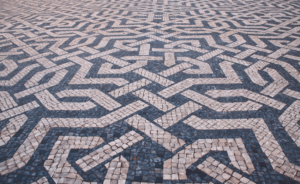Patients of the oldest psychiatric hospital in Lisbon left an artistic footprint
The former hospital Miguel Bombarda in de Rua Dr Almeida Amaral in Lisbon was the first psychiatric hospital in Portugal. The history of the building goes back to the beginning of the 18th century, when there was an estate called Rilhafoles, on which in 1720, a monastery for the nuns of S. Vincent of Paul (Congregação da Missão de S. Vincente do Paulo) was build.

After the Portuguese government banned all religious orders in 1834, the building was occupied by students of the military college (Colégio Militar) until1848, after which it was transformed into a mental hospital called the Rilhafoles Hospital for the Insane (Hospital dos Alienados de Rilhafoles).
In 1892 doctor Miguel Bombarda was appointed director there. This physician, born in Rio de Janeiro, was trained in Lisbon and devoted himself to the mentally ill. He taught at the Medical Faculty on Lisbon’s second hilltop (Campo Santana) and founded – together with the famous surgeon Sousa Martins – the medical journal Medicina Contemporânea.

Under Bombarda’s leadership, a special Security Pavilion was constructed behind the hospital – for patients who had committed a crime – a rare panoptic building. Cells strung together in a circle with a lookout at the centre from which patients could be permanently observed. A model designed by the English philosopher Jeremy Bentham.
In addition to being an inventive physician, Bombarda also was a passionate politician, who wanted to abolish the monarchy. But just one day before the Republic was proclaimed on the 5th of October 1910, he was shot by an ex-patient in his consultation room. One year later, the name of the hospital changed to Hospital Miguel Bombarda, in honor of its late director.

After the closure of the hospital in 2011, a real estate developer bought the hospital grounds to build residential towers on it but the government didn’t allow that since the buildings are part of the cultural heritage. Nowadays, the panopticon is a forgotten building in the heart of Lisbon.
Fortunately, since last year, a group of volunteers is rescuing it from degradation by highlighting the art made by psychiatric patients at the time. Part of that artistic legacy can be admired in two rooms, remnants of a proto-museum founded by the late Bombarda, but since long closed to the public.

Here we encounter paintings from the dancer Valentim de Barros, who spent most of his life in a panoptic cell. Hospitalized in the late 1930s – apparently only for his homosexuality – he died in 1986 on the same day he was discharged. Another patient Jaime Fernandes became famous with his outsider art, which reached the Gulbenkian Foundation and the Bruta Art Collection in Lausanne, Switzerland.
But most of the patients who left work are anonymous, emphasizes Stefanie Franco, a university researcher focusing on the relationship between art and psychiatry, which aroused a vivid interest in the international cultural arena for many years. The pioneering collection of Lausanne – started in 1945 – continues to be a reference.

However, the bulk of the collection – consisting of thousands of drawings, paintings, photographs and tiles – is stored in the basements of the Júlio de Matos Hospital, still to be fully inventoried and waiting for a proper destination. ‘This is a mission’, says Amélia Lérias, a former psychiatrist at Bombarda, charged with the task of inventorying. ‘What we have here is of great wealth and needs institutional protection.’
Enjoy the week Aproveite a semana (pic Público)







